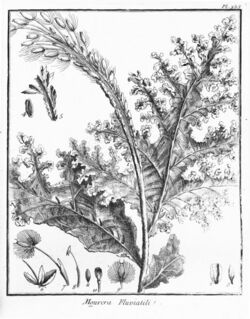Biology:Podostemaceae
| Podostemaceae | |
|---|---|

| |
| Mourera fluviatilis | |
| Scientific classification | |
| Kingdom: | Plantae |
| Clade: | Tracheophytes |
| Clade: | Angiosperms |
| Clade: | Eudicots |
| Clade: | Rosids |
| Order: | Malpighiales |
| Family: | Podostemaceae Rich. ex Kunth[1] |
| Genera | |
|
About 50; see text | |
Podostemaceae (riverweed family), a family in the order Malpighiales, comprise about 50 genera and c. 300 species[2] of more or less thalloid aquatic herbs.
Distribution and habitat
They are found mostly in tropical and subtropical areas worldwide.[3] Many species are found in a very small geographic area, often even just a single river or waterfall.[4][5] Because of their small range, many species are seriously threatened, especially from habitat loss (for example, due to dams flooding their habitat).[5][6]
Riverweeds adhere to hard surfaces (generally rock) in rapids and waterfalls of rivers. They are submerged when water levels are high, but during the dry season they live a terrestrial existence, flowering at this time. Their root anatomy is specialized for the purpose of clinging to rocks, and in fact details of the root structure are one of the ways of classifying riverweeds.[7]
Ecology
In many rivers, Podostemaceae are an important food source for a wide range of animals. For example, the tadpoles of the African goliath frog (world's largest frog) feed only on Dicraeia warmingii,[8] and in South America several serrasalmid fish (Mylesinus, Ossubtus, Tometes and Utiaritichthys) mainly feed on Podostemaceae.[9]
Taxonomy

The Podostemaceae are related to the families Clusiaceae, Hypericaceae (the St. John's wort family, which is sometimes treated as a subfamily of Clusiaceae), and Bonnetiaceae.[11][12] In the classification system of Dahlgren Podostemaceae were placed as a single family in the Podostemales order, which was the only order in the superorder Podostemiflorae (also called Podostemanae).
Genera
Moved to other families
- Hydrostachys from Madagascar. This genus seems to have relatively little in common with any other, and no affinity to the Podostemaceae except being aquatic; moved to its own family in the Cornales.
See also
- Eugenius Warming, a botanist who studied the family
References
- ↑ Angiosperm Phylogeny Group (2009). "An update of the Angiosperm Phylogeny Group classification for the orders and families of flowering plants: APG III" (PDF). Botanical Journal of the Linnean Society 161 (2): 105–121. doi:10.1111/j.1095-8339.2009.00996.x. http://onlinelibrary.wiley.com/doi/10.1046/j.1095-8339.2003.t01-1-00158.x/pdf. Retrieved 2013-07-06.
- ↑ Christenhusz, M. J. M.; Byng, J. W. (2016). "The number of known plants species in the world and its annual increase". Phytotaxa 261 (3): 201–217. doi:10.11646/phytotaxa.261.3.1. http://biotaxa.org/Phytotaxa/article/download/phytotaxa.261.3.1/20598.
- ↑ Podostemaceae at the Encyclopædia Britannica
- ↑ "Podostemaceae". Institute of Systematic Botany, University of Zurich. http://www.systbot.unizh.ch/podostemaceae/index.htm.
- ↑ 5.0 5.1 Bove, C.P.; C.T. Philbrick (2014). "Rediscovery of a Neotropical rheophyte (Podostemaceae) after 160 years: Implications for the location of conservation unit boundaries (Tocantins, Brazil)". Check List 10 (5): 1170–1173. doi:10.15560/10.5.1170.
- ↑ Hettiarachchi, K.; S. Daniel (7 August 2011). "Now vital aquatic plants face similar fate as fish". The Sunday Times. http://www.sundaytimes.lk/110807/News/nws_18.html.
- ↑ Satoshi Koi; Rieko Fujinami; Namiko Kubo; Ikue Tsukamoto; Rie Inagawa; Ryoko Imaichi; Masahiro Kato (2006). "Comparative anatomy of root meristem and root cap in some species of Podostemaceae and the evolution of root dorsiventrality". American Journal of Botany 93 (5): 682–692. doi:10.3732/ajb.93.5.682. PMID 21642132.
- ↑ "Conraua goliath". AmphibiaWeb. https://amphibiaweb.org/cgi/amphib_query?where-scientific_name=Conraua+goliath.
- ↑ Field Guide to the Fishes of the Amazon, Orinoco, and Guianas. Princeton University Press. 2017. pp. 173–196. ISBN 978-0691170749.
- ↑ "Macarenia clavigera" (in ES). El Acuario. https://www.elacuario.org/planta/macarenia-clavigera.
- ↑ Gustafsson, Mats H. G. (2002). "Phylogeny of Clusiaceae Based on rbcL sequences". International Journal of Plant Sciences 163 (6): 1045–1054. doi:10.1086/342521.
- ↑ "Malpighiales". Angiosperm Phylogeny Website. http://www.mobot.org/MOBOT/research/APweb/orders/Malpighialesweb.htm.
- ↑ "Lebbiea (Podostemaceae-Podostemoideae), a new, nearly extinct genus with foliose tepals, in Sierra Leone." Cheek, M. PLOS One, 5 October 2018 (retrieved December 2018)
Further reading
- Kato, Masahiro (2003). "The vague form created by the environment: Podostemaceae". Biohistory 40 (Spring). http://brh.co.jp/en/seimeishi/journal/040/research_11.html.
Wikidata ☰ Q132061 entry
 |

